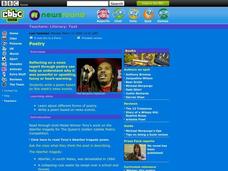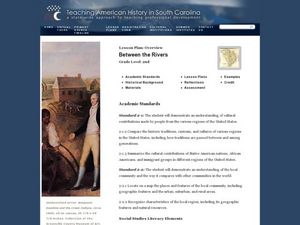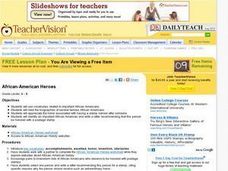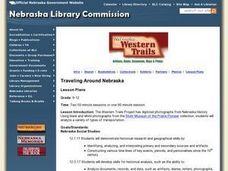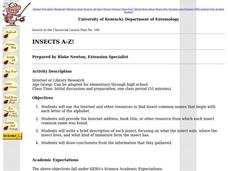Curated OER
Genetics
High schoolers investigate public policy regarding genetic research and have formed an educated opinion on what they believe the government role should be.
Curated OER
Fly, Fly Away
Students use materials from their own environment to design a kite. In this kite design lesson, students research the history of kites and obtain a formal mathematical definition of a kite. Students sketch kite designs after discovering...
Curated OER
Investigating Ocean Life
Sixth graders explore the various forms of ocean life. They research a creature that lives in the ocean. Students use their research information to create a series of HyperStudio stacks about their sea creature.
Curated OER
Hammurabi's Code of Laws
Learners explore why the need arose for laws to govern society, comparing and contrasting hunter/gatherer societies vs. agrarian societies. They write letters to the editor of the Babylonian Times, discussing their opinion of Hammurabi's...
Curated OER
How Safe Is Your Backyard?
Seventh graders investigate the safety of soil and water locally and communicate via the Internet with students in different locales sharing information. They research the Internet using its multimedia capabilities and collate the data...
Curated OER
Poetry
Students reflect on a news report through poetry. Students write a poem based on this week's news events. Students share poems with each other. Students reflect on a poem of their choosing.
Curated OER
Global Eyes
Twelfth graders consider global issues and their effects. They identify the themes of human needs, human rights, and the environment, select a topic and research articles for a Global Current Events Portfolio. Working in small groups,...
Curated OER
Jamestown Colony
Third graders explore cooperation between British settlers and Native Americans in the Jamestown Colony. They describe how the colonists and Powhatan Indians depended on the environment for their survival. Students write a report on the...
Curated OER
Whitman and Lincoln
Young scholars determine if Lincoln and Whitman ever met and write a dialogue between the two men. In this Whitman and Lincoln lesson, students read Whitman's poem "Beat! Beat! Drums!" and connect it to the events of Lincoln's...
Curated OER
Chinese Puzzle Story
Students study the Chinese form of tangrams. They read the story, "Grandfather Tang's Story," by Ann Tompert and discuss how tangrams are used to tell the story. Using paper and scissors, they create animal tangrams and write stories...
Curated OER
Discovering Swahili
Young scholars investigate the African language of Swahili by translating vocabulary words. In this foreign language lesson plan, students write 26 English words that define Africa and utilize the Internet to translate them into...
Curated OER
Between the Rivers
Second graders compare and contrast historical American cultures. In this American history lesson, 2nd graders participate in reading, writing, oral, and hands on activities. Students discuss the similarities and differences between...
Curated OER
Newspapers
Students create a class newspaper about the Olympics. In this newspaper lesson, students discuss the basic characteristics of each component of the newspaper. Students work in small groups to complete stations on cartoons, headlines,...
Curated OER
Applied Science - Science and Math Lab (read without sight)
Students consider the senses. In this sight and touch instructional activity, students discover what it is like to function like a person who is blind. They work in groups and individually on various activities to experience this...
NYC Department of Records
Citizenship and Elections: The Importance of a Ballot
Approximately 58 prcent of those eligible voted in the 2016 US Presidential election. In an attempt to impress upon learners the importance of voting and voting rights, class members examine primary source documents related to the...
Curated OER
Outline and Shine
Seventh graders read and discuss a short story. They complete an outline of the story. They pair and share to evaluate each other's outlines.
Curated OER
Language Arts: Character Comparison
Fourth graders, using Kidspiration, compare and contrast the two main characters from Tales of a Fourth Grade Nothing. They use a teacher-created template to describe their characters. Students then create their own character analysis.
Curated OER
Real or Painted Art -- Tromp l'oeil Art Awareness an Activities
Students are introduced to Trompe l'oeil art by a docent. Using that information, they compare and contast it with other forms of art they are familiar with and discuss their opinions with the class. They write a poem about their...
Curated OER
African-American Heroes
Students explore websites about famous African-Americans. They work in pairs to decide on an African American who should be honored with a stamp. They write a letter recommending this person for a stamp including appropriate reason why...
Curated OER
Issues Close to Home
Students brainstorm as a class about their role in the local government. In groups, they use various types of media to discover how it is affecting their lives. They choose one issue and state their position to share with the class. To...
Curated OER
Two Faces of Paul Gauguin
Students examine Paul Gauguin's self-portraits and letters to explore the individual who created them. They consider how first-person art forms aid the process of self-discovery and produce a symbolic self-portrait
Curated OER
Lesson 1: Design a Transportation Stamp
Students, in groups, research a certain form of transportation that has affected Maine's economic and cultural development. They write a persuasive letter that uses the research to support an argument.
Curated OER
Traveling Around Nebraska
Students analyze a current or historical photograph from their textbook and as a class complete a worksheet of the analysis. Using the Photographic Analysis Form, they locate and analyze two transportation photographs and use the...
Curated OER
Insects A-Z!
Students use the Internet and other resources to find insect common names that begin with each letter of the alphabet. They write a brief description of each insect, focusing on what the insect eats and where the insect lives.







